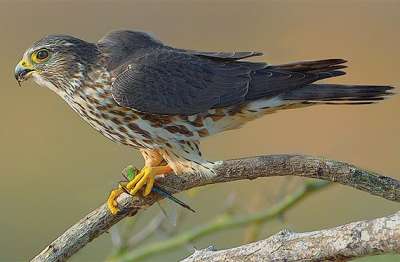On a crisp, sunny day in September, at the end of what was probably a typical summer for a dragonfly (lots of flying around, killing things, and mating beside a pond), a common green darner took off and began to wander south. As it cruised past the summit of Vermont’s Mt. Philo, with Lake Champlain below and the Adirondacks off in the distance, the dragonfly crossed paths with a merlin.
The merlin – a falcon that moves like a fighter jet – specializes in killing songbirds. But when it spotted the fat, juicy dragonfly, the merlin swerved, plucked the darner from the sky with its talons and began to eat on the wing.
So it goes with birds. Many species go off their diets, breaking rules or notions we have about what they eat. Our perceptions give us comfort by imposing a sense of order on nature: Kingfishers eat fish. Hummingbirds drink nectar. Flycatchers catch flies.
Except when they don’t.
Migration is one reason. Besides requiring raw determination and innate navigational skills, migration takes calories, lots of them, stored as fat and burned as fuel on long-distance flights. Insects are a fine source of protein and fat for the trip, a healthy snack for a southbound merlin.
But insects become scarce during the fall migration, which would seem to be a problem for classic insect eaters such as flycatchers and warblers. So the insectivores go for the next best thing: fruit. In one study of 69 bird species stopping on Block Island, Rhode Island, all but one (winter wren) had fruit in their droppings. Least flycatchers, blackpoll warblers, red-eyed vireos, and scores of other self-respecting insectivores find essential fuel in the fruits of viburnum, bayberry, pokeweed, Virginia creeper, and other shrubby plants and vines.
Gram for gram, fruit is lower in lipids and protein than insect tissue. Even so, some birds fare well at the fruit bar, particularly avian omnivores such as tanagers and sparrows, which tend to eat fruit year-round and can maintain body mass and conditioning on a fruit diet during migration.
The classic insectivores in the study, however, did not fare as well when fruit constituted a greater portion of their diet. Yet they often don’t have much choice. On the journey south, songbirds might stop where fruit is the only option. If you were weak and hungry, with miles to go, you might settle for an apple if your hamburger weren’t available.
For many migrants on their way south, the eastern seaboard offers a banquet of fruits such as rose hips, bittersweet, and poison ivy. Bayberry, a waxy source of fat for otherwise insectivorous yellow-rumped warblers and tree swallows, grows in abundance along the east coast. But the coast is also where a good many people live. Ornithologists now recognize the value in keeping these shrubby swaths of habitat (even some invasives) from being replaced by lawns or housing or shopping malls. For many songbirds, it’s not only about the breeding and wintering grounds; it’s also about the fruity turf that lies between.
Whether in migration or not, birds do eat some crazy stuff. I’ve seen a herring gull crush and swallow a large Arctic tern chick and a bald eagle nibble on the leg of a road-flattened northern leopard frog. I’ve watched a snowy owl try to catch fish at sea and a great blue heron unearth and swallow a gopher.
What may seem odd to us, of course, usually isn’t so odd for birds. Nature has a way of toppling our assumptions. Those of us in the Northeast, for example, who see warblers and flycatchers turning from insects to fruit in autumn, might have it backwards. After all, many of those birds came here to nest and to feed their young from our spring flush of black flies, mosquitoes, and inchworm caterpillars. They visit for three or four months of the year – and then they’re gone, back to the tropics to eat fruit.
To my mind, a merlin, no matter how many dragonflies it eats, will always be a songbird killer at heart. But a songbird that we know as insectivorous may, in fact, be a fruitarian that for a few months of the year prefers to eat bugs.


